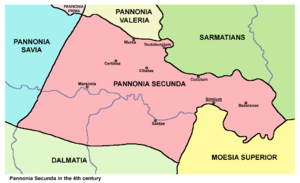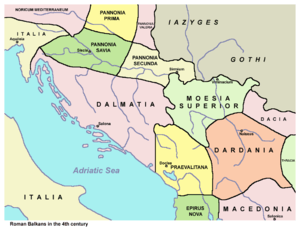Pannonia Secunda
The Pannonia Secunda was one of the provinces of the Roman Empire. It was formed in the year 296, during the reign of emperor Diocletian. The capital of the province was Sirmium (today Sremska Mitrovica). Pannonia Secunda included parts of present-day Serbia, Croatia, and Bosnia and Herzegovina.
| Provincia Pannonia Secunda | |||||||
|---|---|---|---|---|---|---|---|
| province of the Roman Empire | |||||||
| 296–mid-5th century | |||||||
 Pannonia Secunda map | |||||||
| Capital | Sirmium | ||||||
| History | |||||||
• Established | 296 | ||||||
• Hunnic invasions | mid-5th century | ||||||
| |||||||
| Today part of | |||||||

History
Before the creation of this province, its territory was part of the province of Pannonia Inferior. In the year 296, Pannonia Inferior was divided into two provinces - Pannonia Secunda in the south and Pannonia Valeria in the north. The border between the two newly established provinces was the River Drava.
The capital of Pannonia Secunda, Sirmium, was also one of the four capitals of the Roman Empire; several Roman emperors were born in or near this city.
In the year 314, there was a battle between two pretenders to the imperial throne, Constantine the Great and Licinius. The battle occurred in Pannonia Secunda, near the town of Cibalae. Constantine had an army of 20,000 men, while Licinius had 35,000. The battle lasted for the whole day and Constantine was victorious.
Cities
Besides Sirmium, the other cities in Pannonia Secunda were:
- Mursa (today Osijek)
- Certissa (today Đakovo)
- Marsonia (today Slavonski Brod)
- Cibalae (today Vinkovci)
- Bassianae (today Donji Petrovci)
- Cuccium (today Ilok)
- Saldae (today Brčko)
- Teutoburgium (today Dalj)
Prefects
Among the prefects of Pannonia Secunda:
- Aprikanus (355)
- Mesala (373)
- Aurelius Victor, prefect of Pannonia Secunda under Emperor Julian.
See also
- Pannoni
- Pannonia
- Pannonia Inferior
- Pannonia Valeria
- Diocese of Pannonia
- Pannonia (Byzantine province)
- Theme of Sirmium
Literature
- Curta, Florin (2001). "Limes and Cross: the Religious Dimension of the Sixth-century Danube Frontier of the Early Byzantine Empire". Старинар. 51: 45–70.CS1 maint: ref=harv (link)
- Curta, Florin (2001). The Making of the Slavs: History and Archaeology of the Lower Danube Region, c. 500–700. Cambridge: Cambridge University Press.CS1 maint: ref=harv (link)
- Curta, Florin (2006). Southeastern Europe in the Middle Ages, 500–1250. Cambridge: Cambridge University Press.CS1 maint: ref=harv (link)
- Given, John (2014). The Fragmentary History of Priscus. Merchantville, New Jersey: Evolution Publishing.
- Janković, Đorđe (2004). "The Slavs in the 6th Century North Illyricum". Гласник Српског археолошког друштва. 20: 39–61.CS1 maint: ref=harv (link)
- Kazhdan, Alexander (1991). "Sirmium". The Oxford Dictionary of Byzantium. 3. New York: Oxford University Press. p. 1906.
- Kuzmanović, Zorica; Mihajlović, Vladimir D. (2015). "Roman Emperors and Identity Constructions in Modern Serbia". Identities: Global Studies in Culture and Power. 22 (4): 416–432.CS1 maint: ref=harv (link)
- Mirković, Miroslava B. (2017). Sirmium: Its History from the First Century AD to 582 AD. Novi Sad: Center for Historical Research.CS1 maint: ref=harv (link)
- Mócsy, András (2014) [1974]. Pannonia and Upper Moesia: A History of the Middle Danube Provinces of the Roman Empire. New York: Routledge.CS1 maint: ref=harv (link)
- Popović, Radomir V. (1996). Le Christianisme sur le sol de l'Illyricum oriental jusqu'à l'arrivée des Slaves. Thessaloniki: Institute for Balkan Studies.CS1 maint: ref=harv (link)
- Várady, László (1969). Das Letzte Jahrhundert Pannoniens (376–476). Amsterdam: Verlag Adolf M. Hakkert.CS1 maint: ref=harv (link)
- Whitby, Michael (1988). The Emperor Maurice and his Historian: Theophylact Simocatta on Persian and Balkan warfare. Oxford: Clarendon Press.
- Wozniak, Frank E. (1981). "East Rome, Ravenna and Western Illyricum: 454-536 A.D." Historia: Zeitschrift für Alte Geschichte. 30 (3): 351–382.CS1 maint: ref=harv (link)
- Zeiller, Jacques (1918). Les origines chrétiennes dans les provinces danubiennes de l'Empire romain. Paris: E. De Boccard.CS1 maint: ref=harv (link)